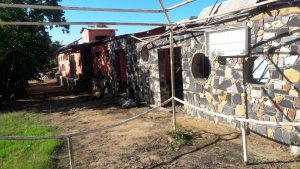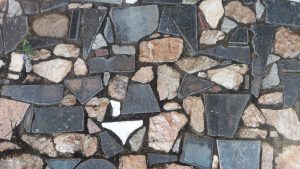Read “Baloyi’s art gallery” by Vonani Bila

John Mehlwana Baloyi (1964–2006) was experimental yet perceptive in his approach to life and the art-making process. He was unpredictable in the subject matter that he handled so meticulously—be it wood carving, pottery, puppetry, or crafts such as baskets, and functional art like chairs and musical instruments. For Baloyi, every fragment of material counted and was highly valued—be it scraps of corrugated iron, tiles, car wheel hubs, and cow dung which he used to build his gallery. Wastage was never a part of Baloyi’s lexicography. Baloyi took art as an embodiment of everything necessary—the living and the dead; the wanted and the discarded. He wanted his gallery to stand out, to reflect the true rural tradition of his Vatsonga people, especially through the brilliant use of cow dung smeared with ethnic patterns on the floor and walls of the gallery. On the other hand, modernity was portrayed through the use of wheel hubs, mirrors, glass, and bricks. I think Baloyi wanted to project the multiplicity of layered meanings of the collected art works—all the varied influences—thus universalizing his unique art experience beyond the confines of his village Zamazama, but without mutating his autonomous touch.

In the context of a changing South Africa—once a broken country whose bones were fractured by the joint devils of apartheid and ruthless white monopoly capital—he saw the black majority oppressed beyond measure: massacred, forcibly uprooted from their settlements and homes, their education disrupted, foreign values imposed on them; many political activists killed in police custody, leaders of the liberation movement banned, jailed, or exiled and the very unlucky ones were executed in Pretoria—while the white South Africans occupied every space of privilege: large tracts of land, despite the expensive cost of maintaining the apartheid machinery. If one glimpses the building pieces which John Baloyi has used to build his gallery, and the journey that South Africa has travelled from apartheid to democracy, you may argue that these pieces are a representation of a broken country put together with strong adhesive.
The gallery mirrors the regrettable and painful past—broken building pieces as shattered dreams. Nonetheless, Baloyi rebuilds a promising future by creating a mosaic that befits the character of a new, happy, and tolerant nation. His dream to erect a gallery was as daunting as Nelson Mandela’s dream of rebuilding a broken country with its sharp racial conflagration and glaring socio-economic discrepancies characterized by structural displacement, rampant unemployment, high HIV/AIDS prevalence, unnecessary infant mortality, sub-standard housing, poor health care, and landlessness of the black majority. But with the patience and measured artistry of Baloyi, like Nelson Mandela’s reconciliatory spirit and articulation, he was able to reconstruct a new country, a new home without rivers of blood gushing. He rebuilt a fractured country’s bones with broken pieces without dwelling on negative factors that would impede the realization of his dream. For me, Baloyi’s art gallery inspires hope, stimulates discourse on rurality and historicity, the reconstruction of national identity, spirit of self-sufficiency and hard work as virtues of any successful project. But with the bucketing rains that often invade the gallery, my biggest fear is that Baloyi’s much-valued possessions—wood carvings—will dissolve piece by piece, because of the leaking roof. The ants will also burrow these neglected carvings as if to emphasize that nothing on earth, including art, is permanent.
John Baloyi was my friend. Some people that he grew up with affectionately called him Sure—the name he earned as a soccer player. The Baloyi I know had taste for high life, but was surely not greedy or corrupt. He was tremendously hard-working. He drove a Jaguar, had a pick-up truck and a panel van while most of his contemporaries were badly struggling. With his truck, he was able to collect large and hard wood as far afield as Kruger National Park—80 kilometres from his village—to carve his dragons. These works were refreshingly unique and hard to file. But nothing was impossible with Baloyi. Although he was diminutive in stature, his hands and shoulders were strong and broad. His heart was the deep and wide ocean, and his brain razor-sharp.
Baloyi had big ideas about life and art. He was ahead of his time in his imagination of the world and the role of artist in shaping an exciting, peaceful world. He was part of a set of visual artists from the Limpopo Province who were mentored by Jackson Hlungwani—the bearded sculptor with dangling dreadlocks I regard as the father of woodcarving in South Africa. Instead of imitating Hlungwani, who was obsessed with carving aquatic figures, biblical themes, and religious symbols, Baloyi discovered his own style. Yes, he too explored the biblical themes, but his world was mainly populated by gargantuan figures of foreign animal species such as camels, dolphins, kangaroos, and swordfish. Baloyi was equally fascinated by European history and third-world politics. He transformed wood to capture the ideas and actions of historical figures like Napoleon Bonaparte and Mussolini. Through his art, we witness the unfolding of history and the changing political faces. Baloyi couldn’t wait for handouts. He believed in self-sustenance and the utopian spirit of collectivism, that’s why he embarked on building his gallery, a project which took him over ten years. This project entailed a lifetime of brainstorming, long hours of stitching and unstitching; construction and deconstruction. He asked some of the local but leading sculptors such as Lucky Makamu, David Murathi, Thomas Kubayi, Jackson Hlungwani, Owen Ndou, Sarah Munyai, and the Mukondeni clay pot makers to house their works in the gallery. The gallery was Baloyi’s idea to organize the unorganized artists, especially those on the edges like him. The art gallery would create a demand for art works from, hopefully, the new black elite. It would also serve as an arts centre in the area, thus nurturing the next generation of wood carvers, beaders, clay pot makers, and weavers.
At the time of Baloyi’s untimely death, the gallery was still not complete, but luckily he had installed most of his huge carvings, which, in case he decided to sell, would sell at exorbitant prices. Baloyi died in an accident when the brakes failed on a bakkie he was travelling in. The bakkie driver couldn’t stop at an intersection on the N1 highway and a bus slammed into the side of the bakkie. Baloyi died before his dream and thoughts could fully come to maturity.
“Baolyi’s art gallery” appears in NER 38.4
order a copy today — or better yet, subscribe!